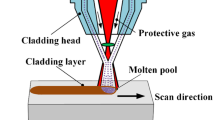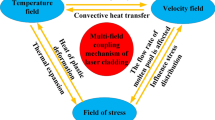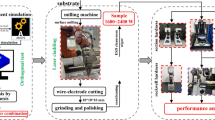Abstract
Nodular cast iron is widely used in the industrial field, but its wear resistance and corrosion resistance are poor. Laser cladding technology is an effective way to strengthen its surface. The cladding layer is formed by multi-track sequential overlapping. The thermal-elastic–plastic-flow coupling evolution behaviors among different cladding channels have a direct interaction. Quantitatively revealing the multi-field coupling correlation is significant for optimizing process parameters and effectively improving the quality of cladding layer. In this paper, a multi-field coupling model of nodular cast iron with multi-track overlapping in laser cladding is established, which reveals the instantaneous evolution law and correlation effects. The calculation shows that the maximum temperature of the first cladding is 2500 K, the maximum stress is 417 MPa, the stress area presents a shrinkage band distribution, and the maximum flow velocity of the molten pool is 0.24 m/s. Under the influence of active elements, the Marangoni flow direction will be reversed. The two cladding mechanisms of sequential overlapping cladding and the second cladding after air cooling to room temperature were compared and analyzed. The result shows that the energy accumulation is greater under the first cladding mechanism; the temperature and the steady-state flow rate are relatively high. Under the second cladding mechanism, the change of flow velocity is not obvious. The size and micromorphology of the cladding layer were observed by the Therom Scientific Apreo 2S field emission SEM, and the cladding temperature at different positions was measured by the Testo 885 thermal imager, verified the validity of the model.

























Similar content being viewed by others
Data availability
The authors confirm that the data supporting the findings of this study are available within the article.
References
Padasale B, Sondar P, Hegde SR (2021) Effect of spheroidization of cementite in ductile cast iron. Int J Min Met Mater 28(3):8. https://doi.org/10.1007/s12613-020-2041-0
Rajendran I, Madhusudhanan S (2017) An investigation on the fatigue performance of austempered ductile iron steering knuckle. Int J Heavy Veh Syst 1(1):1. https://doi.org/10.1504/IJHVS.2018.094822
Çevik G, Gürbüz R (2013) Evaluation of fatigue performance of a fillet rolled diesel engine crankshaft. Eng Fail Anal 27:250–261. https://doi.org/10.1016/j.engfailanal.2012.07.026
Jingl Z (2013) Prediction of failure of cast iron with dynamic loading and high temperature. Mat Sci Eng A-Struct, 566(mar.20):71–81. https://doi.org/10.1016/j.msea.2012.12.085
Takemoto Y, Mizumoto M, Kinno K (2020) Internal porosity defects in ductile cast irons. Int J Metalcast 15:916–929. https://doi.org/10.1007/s40962-020-00527-x
Turichin GA, Zemlyakov EV, Pozdeeva EY, Tuominen J, Vuoristo P (2012) Technological possibilities of laser cladding with the help of powerful fiber lasers. Met Sci Heat Treat 54(3–4):139–144. https://doi.org/10.1007/s11041-012-9470-y
Benoit MJ, Mazur M, Easton MA, Brandt M (2021) Effect of alloy composition and laser powder bed fusion parameters on the defect formation and mechanical properties of Inconel 625. Int J Adv Manuf Tech 114(3):915–927. https://doi.org/10.1007/s00170-021-06957-z
Hofman JT, Lange DFD, Pathiraj B, Meijerb J (2011) FEM modeling and experimental verification for dilution control in laser cladding. J Mater Process Tech 211(2):187–196. https://doi.org/10.1016/j.jmatprotec.2010.09.007
Hao M, Sun Y (2013) A FEM model for simulating temperature field in coaxial laser cladding of TI6AL4V alloy using an inverse modeling approach. Int J Heat Mass Tran 64(sep.):352–360. https://doi.org/10.1016/j.ijheatmasstransfer.2013.04.050
Yi P, Xu P, Fan C, Li C, Shi Y (2015) The effect of dynamic local self-preheating in laser cladding on grey cast iron. Stroj Vestn-J Mech E 61(1):43–52. https://doi.org/10.5545/sv-jme.2014.1807
Li C, Yu Z, Gao J, Zhao J, Han X (2018) Numerical simulation and experimental study of cladding Fe60 on an ASTM 1045 matrix by laser cladding. Surf Coat Tech 357:965–977. https://doi.org/10.1016/j.surfcoat.2018.10.099
Gao L, Wu C, Hao Y, Xu X, Guo L (2020) Numerical simulation and experimental investigation on three-dimensional modelling of single-track geometry and temperature evolution by laser cladding. Opt Laser Technol. https://doi.org/10.1016/j.optlastec.2020.106287
Wang Q, Zeng X, Chen C, Lian G, Huang X (2020) An integrated method for multi-objective optimization of multi-pass Fe50/TiC laser cladding on AISI 1045 steel based on grey relational analysis and principal component analysis. Coatings 10(2):151. https://doi.org/10.3390/coatings10020151
Li C, Zhang DC, Yang YP, Gao HX, Han X (2021) Research on sputtering behavior of three beams coaxial laser cladding powder based on the interaction of lasers and powder. J Laser Appl 33:042020. https://doi.org/10.2351/7.0000449
Zhang P, Ma L, Zhao J, Yuan J, Hu J (2006) The heat source model of the numerical simulation in the laser cladding. China Surf Eng 19(7):161–164. https://doi.org/10.3321/j.issn:1007-9289.2006.z1.041
Tian H, Chen X, Yan Z, Zhi X, Yang Q, Yuan Z (2019) Finite-element simulation of melt pool geometry and dilution ratio during laser cladding. Appl Phys A-Mater 125(7):485.1–485.9. https://doi.org/10.1007/s00339-019-2772-9
Li C, Yu ZB, Gao JX, Zhao JY, Han X (2019) Numerical simulation and experimental study on the evolution of multi-field coupling in laser cladding process by disk lasers. Weld World 63:925–945. https://doi.org/10.1007/s40194-019-00725-0
Zhao GH, Mao H, Louzguine-Luzgin DV (2016) Glass forming range of the Ti-Fe-Si amorphous alloys: an effective materials-design approach coupling CALPHAD and topological instability criterion. J Appl Phys 120(20):205106. https://doi.org/10.1063/1.4968585
Li S, Yi L, Jia X, Xiang D, Liu T, Ji B (2020) A dense and compact laser cladding layer with solid metallurgical bonding significantly improved corrosion resistance of Mg alloy for engineering applications. Mater Corros. https://doi.org/10.1002/maco.202011565
Jiang Y, Cheng Y, Zhang X, Yang J, Yang X, Cheng Z (2019) Simulation and experimental investigations on the effect of Marangoni convection on thermal field during laser cladding process. Optik. https://doi.org/10.1016/j.ijleo.2019.164044
Qi K, Yang Y, Hu G, Lu X, Li J (2020) Thermal expansion control of composite coatings on 42CrMo by laser cladding. Surf Coat Tech 397:125983.https://doi.org/10.1016/j.surfcoat.2020.125983
Funding
This work was supported by Innovation Talent Support Plan Program of Higher Education Institutions of Liaoning Province (20201020) and National Key R&D Program “Advanced Structures and Composite Materials” of China (2021YFB3702002).
Author information
Authors and Affiliations
Corresponding author
Ethics declarations
Ethics approval
Not applicable.
Consent to participate
Not applicable.
Consent for publication
All authors consented to the publication.
Competing interests
The authors declare no competing interests.
Additional information
Publisher's Note
Springer Nature remains neutral with regard to jurisdictional claims in published maps and institutional affiliations.
Rights and permissions
Springer Nature or its licensor holds exclusive rights to this article under a publishing agreement with the author(s) or other rightsholder(s); author self-archiving of the accepted manuscript version of this article is solely governed by the terms of such publishing agreement and applicable law.
About this article
Cite this article
Han, X., Li, C., Xu, Y. et al. Correlation research on multi-field coupling of multi-track overlapping laser cladding process for nodular cast iron. Int J Adv Manuf Technol 121, 5707–5729 (2022). https://doi.org/10.1007/s00170-022-09842-5
Received:
Accepted:
Published:
Issue Date:
DOI: https://doi.org/10.1007/s00170-022-09842-5




